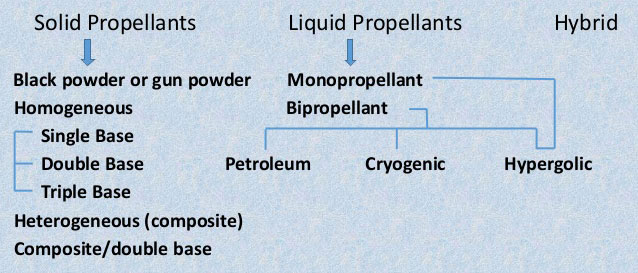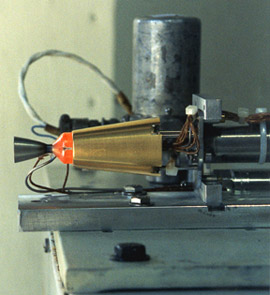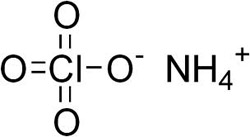rocket propellants

Types of chemical rocket propellant (not including gaseous propellants).
A propellant is a substance or substances used to furnish the exhaust material which, when allowed to escape from a rocket, provides thrust. A propellant consists of a fuel and an oxidizer. A fuel is a substance which burns when combined with oxygen producing gas for propulsion. An oxidizer is an agent that releases oxygen for combination with a fuel.
An additive is a substance added to a propellant for any of a variety of reasons, including to stabilize or achieve a more even rate of combustion, to make ignition easier, to lower the freezing point of the propellant (to prevent it freezing in space), or to reduce corrosive effects.
Most rocket engines use chemical propellants, which can be classified as liquid propellants, solid propellants, gelled propellants, hybrid propellants, or gaseous propellants depending on their physical state. In an ion propulsion system the propellant particles are first ionized and then accelerated to yield a high-speed exhaust. The gauge for rating the efficiency of rocket propellants is specific impulse.
Liquid propellant
A liquid propellant is a propellant used in a liquid-propellant rocket engine. A good liquid propellant is one with a high specific impulse. This implies a high combustion temperature and exhaust gases with small molecular weights. However, another important factor is the density of the propellant. Lower density propellants require larger storage tanks, thus increasing the mass of the launch vehicle. Storage temperature is also important. A propellant with a low storage temperature, i.e. a cryogenic, requires thermal insulation, thus further increasing the mass of the launcher. The toxicity of the propellant yet another consideration. There are safety hazards in handling, transporting, and storing highly toxic compounds. Also, some propellants are very corrosive, however, materials that are resistant to certain propellants have been identified for use in rocket construction. Some liquids that were used to propel early liquid propellant rockets, including aniline and hydrogen peroxide, are no longer used.
Three main categories of liquid propellants may be distinguished:
• anergolic
• hypergolic
• cryogenic
Additionally, liquid propellants may be classed as bipropellants (in which a liquid fuel and a liquid oxidizer are stored separately) or monopropellants.
Anergolic propellant
An anergolic propellant is a liquid propellant in which, in contrast to a hypergolic propellant, the liquid fuel and liquid oxidizer do not burn spontaneously when they come into contact. Examples include: liquid oxygen and ethanol, white fuming nitric acid (WFNA) and jet engine fuel, and liquid oxygen and liquid hydrogen.
Hypergolic propellant
A hypergolic propellant is a liquid propellant in which the fuel ignites spontaneously upon contact with an oxidizer, thereby eliminating the need for an ignition system. The easy start and restart capability of hypergolics make them ideal for spacecraft maneuvering systems. Also, since hypergolics remain liquid at normal temperatures, they don't pose the storage problems of cryogenic propellants. On the debit side, hypergolics are highly toxic and must be handled with extreme care.
Hypergolic fuels commonly include hydrazine, monomethyl hydrazine (MMH), and unsymmetrical dimethyl hydrazine (UDMH). The oxidizer is typically nitrogen tetroxide (N2O4) or nitric acid (HNO3).
Cryogenic propellant
A cryogenic propellant is a form of liquid propellant for rocket engines that must be kept at very low temperatures to remain liquid. The commonest examples are liquid hydrogen and liquid oxygen. Cryogenic propellants require special insulated containers and vents to allow gas from the evaporating liquids to escape. The liquid fuel and oxidizer are pumped from the storage tanks to an expansion chamber and injected into the combustion chamber where they are mixed and ignited by a flame or spark.
Because of the low temperatures of cryogenic propellants, they are difficult to store over long periods of time. For this reason, they are less desirable for use in military rockets which must be kept launch ready for months at a time. Also, liquid hydrogen has a very low density (0.59 pounds per gallon) and, therefore, requires a storage volume many times greater than other fuels. Despite these drawbacks, the high efficiency of liquid hydrogen/liquid oxygen makes these problems worth coping with when reaction time and storability are not too critical. Liquid hydrogen delivers a specific impulse about 40% higher than other rocket fuels.
Liquid hydrogen and liquid oxygen are used as the propellant in the high efficiency main engines of the Space Shuttle. LH2/LO2 also powered the upper stages of the Saturn V and Saturn lB rockets as well as the second stage of the Atlas-Centaur launch vehicle – the United States' first LH2/LO2 rocket (1962).
Bipropellant
A bipropellant is a rocket propellant consisting of two substances, the fuel and the oxidizer, that are held separate prior to combustion. Bipropellants are commonly used in liquid-propellant rocket engines. There are many examples, including RP-1 (a kerosine-containing mixture) and liquid oxygen (used by the Atlas family), and liquid hydrogen and liquid oxygen (used by the Space Shuttle).
Monopropellant
A monopropellant is a single liquid, used in a liquid-propellant rocket engine, that serves as both fuel and oxidizer. A monopropellant decomposes into a hot gas when an appropriate catalyst is introduced. The commonest example is hydrazine, often used in spacecraft attitude control jets.
 |
| HAN-based monopropellant thruster test at Primex Aerospace. Credit: Primex Aerospace / Aerojet. |
HAN (hydroxylammonium nitrate) is a relatively new, synthetic, rocket fuel with the chemical formula NH2OH+NO3. HAN has the potential to be used both as a liquid monopropellant and an ingredient in solid propellants. It has the advantage of being more environmentally friendly than the toxic hydrazine presently used in thrusters on most spacecraft.
| PROPERTIES OF LIQUID ROCKET PROPELLANTS | |||||
|---|---|---|---|---|---|
| compound |
chemical formula |
mol weight |
density |
m. pt |
b. pt |
O2 |
32.00 |
1.141 |
-218.8°C |
-183.0°C |
|
N2O4 |
92.01 |
1.45 g/ml |
-9.3°C |
21.15°C |
|
HNO3 |
63.01 |
1.55 g/ml |
-41.6°C |
83°C |
|
H2 |
2.016 |
0.071 g/ml |
-259.3°C |
-252.9°C |
|
N2H4 |
32.05 |
1.004 g/ml |
1.4°C |
113.5°C |
|
CH3NHNH2 |
46.07 |
0.87 g/ml |
-52.4°C |
87.5°C |
|
(CH3)2NNH2 |
60.10 |
0.79 g/ml |
-58°C |
63.9°C |
|
hydrocarbon CH1.97 |
~175 |
0.58 g/ml |
-9.6°C |
216.3°C |
|
Some important liquid rocket propellants
Hydrazine (N2H4) is a clear, fuming, corrosive, highly toxic covalent hydride with a fishy smell. It is used as a liquid rocket fuel, both as a monopropellant, especially in attitude control thrusters, and as a bipropellant. As a monopropellant in catalytic decomposition engines, it is ignited by passing it over a heated catalyst (alumina pellets impregnated with iridium) that decomposes the fuel and produces ammonia, nitrogen, and hydrogen exhaust gases. The decomposition of hydrazine produces temperatures of about 925°C (1,700°F) and a specific impulse of 230–240 seconds. As a bipropellant it is also a hypergolic propellant used, for example, in the second stage of the Titan family of launch vehicles in a 50% hydrazine / 50% UDMH mixture known as Aerozine 50.
Liquid hydrogen
Liquid hydrogen is used as a cryogenic propellant in rocket engines. Hydrogen gas turns to liquid under standard atmospheric pressure at –262.9°C. When oxidized by liquid oxygen, liquid hydrogen delivers about 40% more thrust per unit mass than other liquid fuels, such as kerosene. Molecular weight: 2.016; density: 0.071 grams per milliliter. Commonly referred to in rocketry as LH2.
Liquid oxygen
Liquid oxygen is used as the oxidizer in many liquid-propellant rocket engines. Oxygen gas turns to liquid under standard atmospheric pressure at -183°C. Molecular weight: 32; density: 1.141 grams per milliliter. Commonly referred to in rocketry as LOX.
Monomethyl hydrazine (MMH)
MMH (monomethyl hydrazine) is a clear, colorless, hygroscopic liquid, with the chemical formula CH3NHNH2, that is derived from hydrazine. It is used as a hypergolic liquid rocket fuel, with nitrogen tetroxide as an oxidizer, in the orbital maneuvering system (OMS) and reaction control system (RCS) of the Space Shuttle Orbiter. The specific impulse of the MMH/N2O4 combination in the Space Shuttle orbiter ranges from 260 to 280 seconds in the RCS, to 313 seconds in the OMS. The higher efficiency of the OMS system is attributed to higher expansion ratios in the nozzles and higher pressures in the combustion chambers.
Nitric acid
Nitric acid was commonly used as an oxidizer in liquid-propellant rocket engines between 1940 and 1965. It most often took the form of RFNA (red fuming nitric acid), containing 5–20% dissolved nitrogen dioxide. Compared to concentrated nitric acid (also known as white fuming nitric acid), RFNA is more energetic and more stable to store but produces poisonous red-brown fumes. Because nitric acid is normally highly corrosive it can only be stored and piped by a few materials such as stainless steel. However, the addition of a small concentration of fluoride ions inhibits the corrosive action and gives a form known as IRFNA (inhibited red fuming nitric acid). Like nitrogen tetroxide, it is hypergolic (reacts upon contact with) hydrazine, MMH (monomethyl hydrazine), and UDMH (unsymmetrical dimethyl hydrazine).
Nitrogen tetroxide
Nitrogen tetroxide (N2O4) is a yellow-brown liquid that is among the most common storable oxidizers used by liquid-propellant rocket engines today. Like nitric acid, it is hypergolic (reacts upon contact with) hydrazine, MMH (monomethyl hydrazine), and UDMH (unsymmetrical dimethyl hydrazine). It is used, for example, with MMH in the Space Shuttle orbital maneuvering system. Although it can be stored indefinitely in sealed containers, its liquid temperature range is narrow and it is easily frozen or vaporized.
RP-1
RP-1 (rocket propellant 1) is a highly-refined, special grade of kerosene used in a wide variety of rocket engines. Together with liquid oxygen, it provides, or has provided, the propellant for the first stages of rockets such as the Atlas, Thor, Delta, Titan I, and Saturn 1B and V. The reason RP-1(kerosene) is often used in first stages is that it provides a lot of energy per liter – 4 times more than a liter of liquid hydrogen, for example. When building a rocket, the more liters of fuel that have to be carried the bigger the rocket has to be. The bigger the rocket, the more air it has to push aside as it speeds up, which uses up valuable energy that should be used getting the rocket up higher. Once high enough above the ground, the size of the rocket becomes less of a consideration because the air is much thinner. The biggest consideration then becomes the weight, which is why a lighter fuel such as liquid hydrogen becomes preferable for the second and third stages.
RP-1's formulation stemmed from a program begun in 1953 by Rocketdyne to improve the engines being developed for the Navaho and Atlas missiles. Prior to that a large number of petroleum-based rocket propellants had been used. Robert Goddard had begun with gasoline, and other experimental engines had been powered by kerosene, diesel oil, paint thinner, and jet-fuel kerosene. The wide variation in physical properties among fuels of the same class led to the identification of narrow-range petroleum fractions, embodied in 1954 in the standard United States kerosene rocket fuel RP-1, covered by Military Specification MIL-R-25576. In Russia, similar specifications were developed for kerosene under the specifications T-1 and RG-1. RP-1 is a kerosene fraction, obtained from crude oil with a high napthene content which is subjected to further treatment, including acid washing and sulfur dioxide extraction.
Unsymmetrical dimethyl hydrazine (UDMH)
Unsymmetrical dimethylhydrazine (UDMH) is a hypergolic liquid rocket fuel derived from hydrazine. It has the chemical formula N(CH3)2NH2. UDMH is often used instead of, or in mixtures with, hydrazine because it improves stability, especially at higher temperatures. UDMH is employed by many Russian, European, and Chinese rockets. The Titan family of launch vehicles and the second stage of the Delta use a fuel called Aerozine 50, which is a mixture of 50% UDMH and 50% hydrazine.
Solid propellant
A solid propellant is a rocket propellant in solid form used in a solid-propellant rocket motor. It usually contains both fuel and oxidizer combined, or mixed and formed, into a monolithic (not powdered or granulated) grain. There are two families of solids propellants: homogeneous and composite. Both types are dense, stable at ordinary temperatures, and easily storable.
Homogenous propellant
A homogeneous propellant may be either simple base or double base. A simple base propellant consists of a single compound, usually nitrocellulose, which has both an oxidation capacity and a reduction capacity. Double base propellants usually consist of nitrocellulose and nitroglycerin, to which a elasticizer, or plasticizer, is added. The elasticizer is an elastic substance or fuel used to prevent cracking of the propellant grain and to bind it to the combustion chamber case.
Homogeneous propellants do not usually have specific impulses greater than about 210 seconds under normal conditions. Their main asset is that they do not produce traceable fumes and are, therefore, commonly used in tactical weapons. They are also often used to perform subsidiary functions such as jettisoning spent parts or separating one stage from another.
Composite propellant
Modern composite propellants are heterogeneous powders (mixtures) which use a crystallized or finely ground mineral salt as an oxidizer, often ammonium perchlorate, which constitutes between 60% and 90% of the mass of the propellant. Ammonium perchlorate is a white crystalline solid, the salt of ammonia and perchloric acid (HClO4). It is the oxidizer used in most composite rocket motors, including those of the Space Shuttle Solid Rocket Boosters.
 |
| Ammonium perchlorate |
The fuel itself is powdered aluminum, consisting of round particles, 5–60 micrometers in diameter. The propellant is held together by a polymeric binder, usually polyurethane or polybutadienes. Additional compounds are sometimes included, such as a catalyst to help increase the burning rate, or other agents to make the powder easier to manufacture. The final product is rubberlike substance with the consistency of a hard rubber eraser.
Hybrid propellant
A hybrid propellant is a form of chemical rocket propellant in which the fuel and oxidizer are in different physical states. One of the substances is solid, usually the fuel, while the other, usually the oxidizer, is liquid. The liquid is injected into the solid, whose fuel reservoir also serves as the combustion chamber.
Gaseous propellant
A gaseous propellant is a working substance used in a gaseous-propellant rocket engine.
Nitrogen, argon, krypton, dry air, and Freon 14 have all been employed in spacecraft.
Propellant storage
Liquid rocket propellants need special storage and handling – the most appropriate methods depending on the type of fuel and oxidizer used. On most launch vehicles the fuel and oxidizer tanks are stacked vertically, with the fuel tank on top so that its greater density shifts the center of gravity forward and thereby increases the vehicle's stability. Typically, the space above the remaining propellant is pressurized by external gas lines at the top of each tank. This prevents a vacuum from developing and keeps the propellant flowing smoothly. The gas pressurization lines may use inert gas from a separate tank, or products from the engine itself. Cryogenic propellants have to be carefully insulated and, prior to launch, recirculated through an umbilical to an external cooler. Many tanks, and all cryogenic tanks, have a bleed valve to allow high pressure gases to escape. Because cryogenic tanks aboard spacecraft cannot store propellants for long, they are usually limited to launch vehicles.


